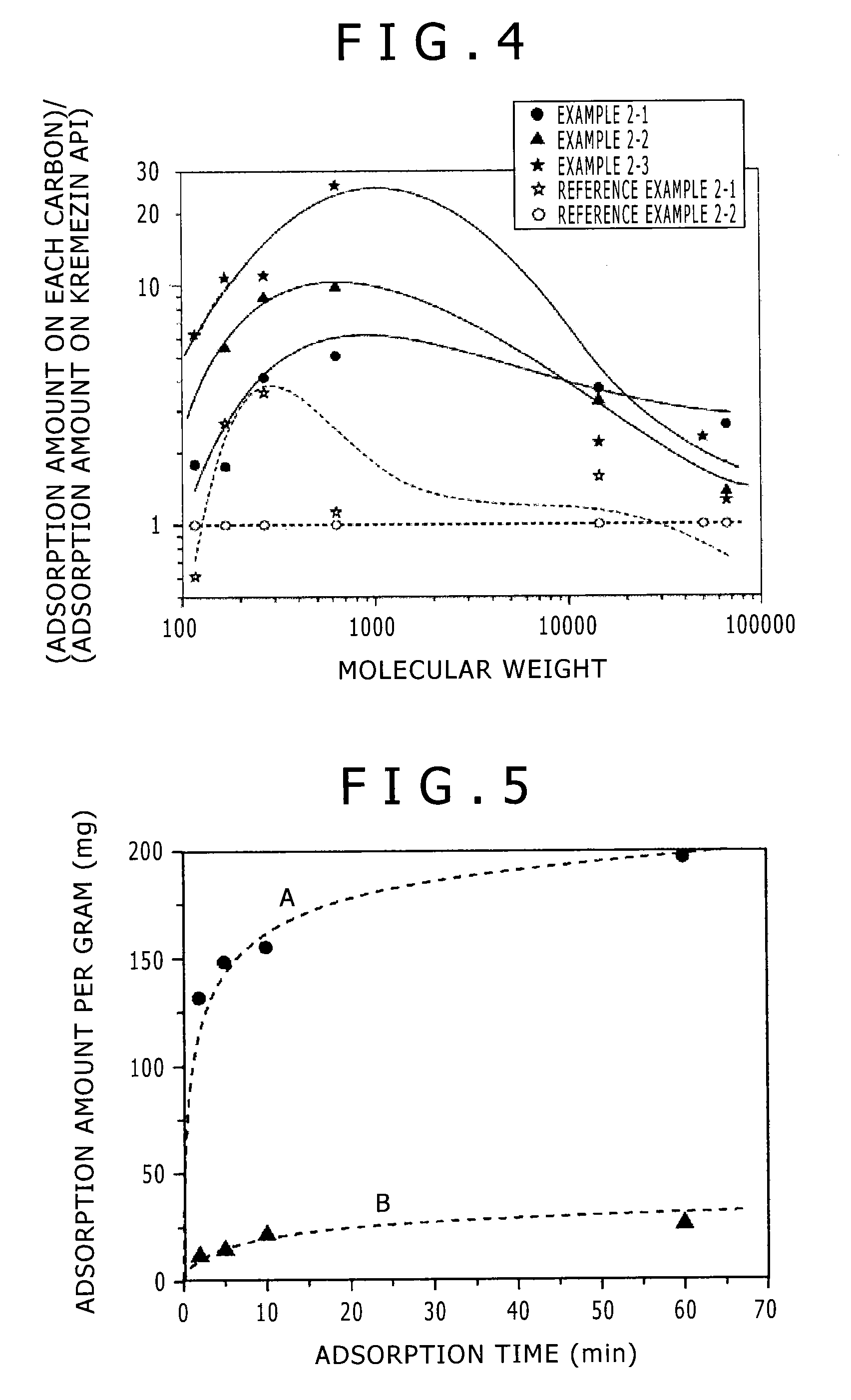Adsorbent, cleansing agent, renal disease drug, and functional food
a technology of cleansing agent and adsorbent, which is applied in the direction of anti-noxious agents, drug compositions, chemistry apparatus and processes, etc., can solve the problems of insufficient cleaning effect or skin-conditioning effect, and the technology of carbonizing treatment of plant-derived materials is not yet sufficient, so as to achieve excellent properties, excellent functionality and characteristics, and high specific surface area value
- Summary
- Abstract
- Description
- Claims
- Application Information
AI Technical Summary
Benefits of technology
Problems solved by technology
Method used
Image
Examples
example 1
[0049]First, in Example 1, description will be made of a porous carbon material suitable for constituting the adsorbents according to the first to fifteenth embodiments of the present invention described in Example 2 later, the adsorbents for oral administration according to the invention, and the cleansing agents according to the invention, and a method for producing the porous carbon material.
[0050]In Example 1, the plant-derived material as a raw material for the porous carbon material is husks of rice. The porous carbon material in Example 1 is obtained by converting the rice husks as raw material into a carbonaceous material (porous carbon material precursor) by carbonization, and then treating the carbonaceous material with an acid.
[0051]In production of the porous carbon material, first, pulverized rice husks (rice husks of Isehikari rice produced in Kagoshima prefecture, Japan) was subjected to a heating treatment (pre-carbonizing treatment) in an inert gas. Specifically, th...
example 2
[0060]In relation to the adsorbents according to the first to fifteenth embodiments of the present invention, the adsorbent for oral administration according to the invention and the cleansing agent according to the invention, the porous carbon materials obtained in Example 1 were applied in Example 2 as a porous carbon material for selective adsorption of various unrequired molecules present in the living body, a porous carbon material for removal of dirt components, or a porous carbon material for an oral adsorbent. Then, adsorption amounts of various substances per unit weight of porous carbon material were measured.
[0061]In measuring the adsorption amount, first, 14 kinds of substances differing in number average molecular weight (number average M.W.), that is, indole (number average M.W.: 117), uric acid (number average M.W.: 168), adenosine (number average M.W.: 267), α-amylase (number average M.W.: about 50000), 3-methylindole (number average M.W.: 131), theophylline (number ...
example 3
[0084]Example 3 is a modification of Example 2. In Example 3, the surface of the porous carbon material of Example 2-1 described in Example 2 was chemically modified with organic molecules.
[0085]Specifically, using a 500-mL eggplant-shaped flask, 3.0 g of the porous carbon material of Example 2-1 and 300 mL of concentrated nitric acid were mixed with each other, and the mixture was stirred at room temperature for 12 hours. Thereafter, the resulting carbon material was washed with pure water. For the porous carbon material thus obtained (referred to as the porous carbon material of Example 3-A), a peak indicative of carboxyl group (C═O: 1500 cm−1) and a peak indicative of hydroxyl group (—OH: 3700 cm−1) could be observed by IR spectrometry, whereby the presence of carboxyl groups could be confirmed. FIG. 6 shows the IR absorption spectra, in which the IR absorption spectrum shown at the bottom of FIG. 6 is the IR absorption spectrum for the porous carbon material of Example 2-1, and ...
PUM
| Property | Measurement | Unit |
|---|---|---|
| Specific surface area | aaaaa | aaaaa |
| Specific volume | aaaaa | aaaaa |
| Volume | aaaaa | aaaaa |
Abstract
Description
Claims
Application Information
 Login to View More
Login to View More - R&D
- Intellectual Property
- Life Sciences
- Materials
- Tech Scout
- Unparalleled Data Quality
- Higher Quality Content
- 60% Fewer Hallucinations
Browse by: Latest US Patents, China's latest patents, Technical Efficacy Thesaurus, Application Domain, Technology Topic, Popular Technical Reports.
© 2025 PatSnap. All rights reserved.Legal|Privacy policy|Modern Slavery Act Transparency Statement|Sitemap|About US| Contact US: help@patsnap.com



